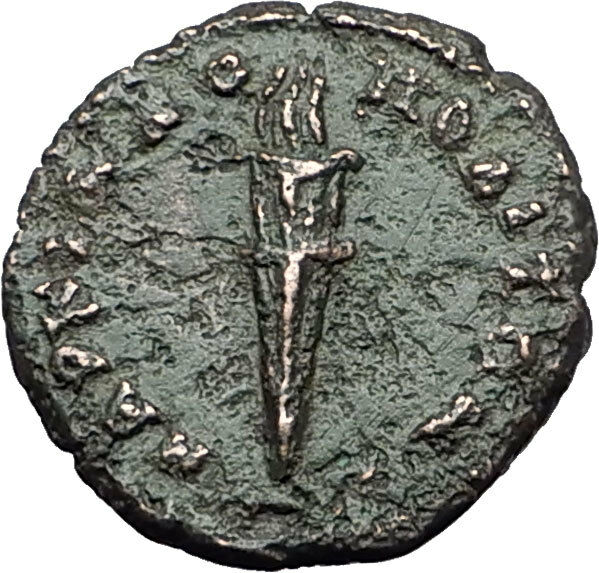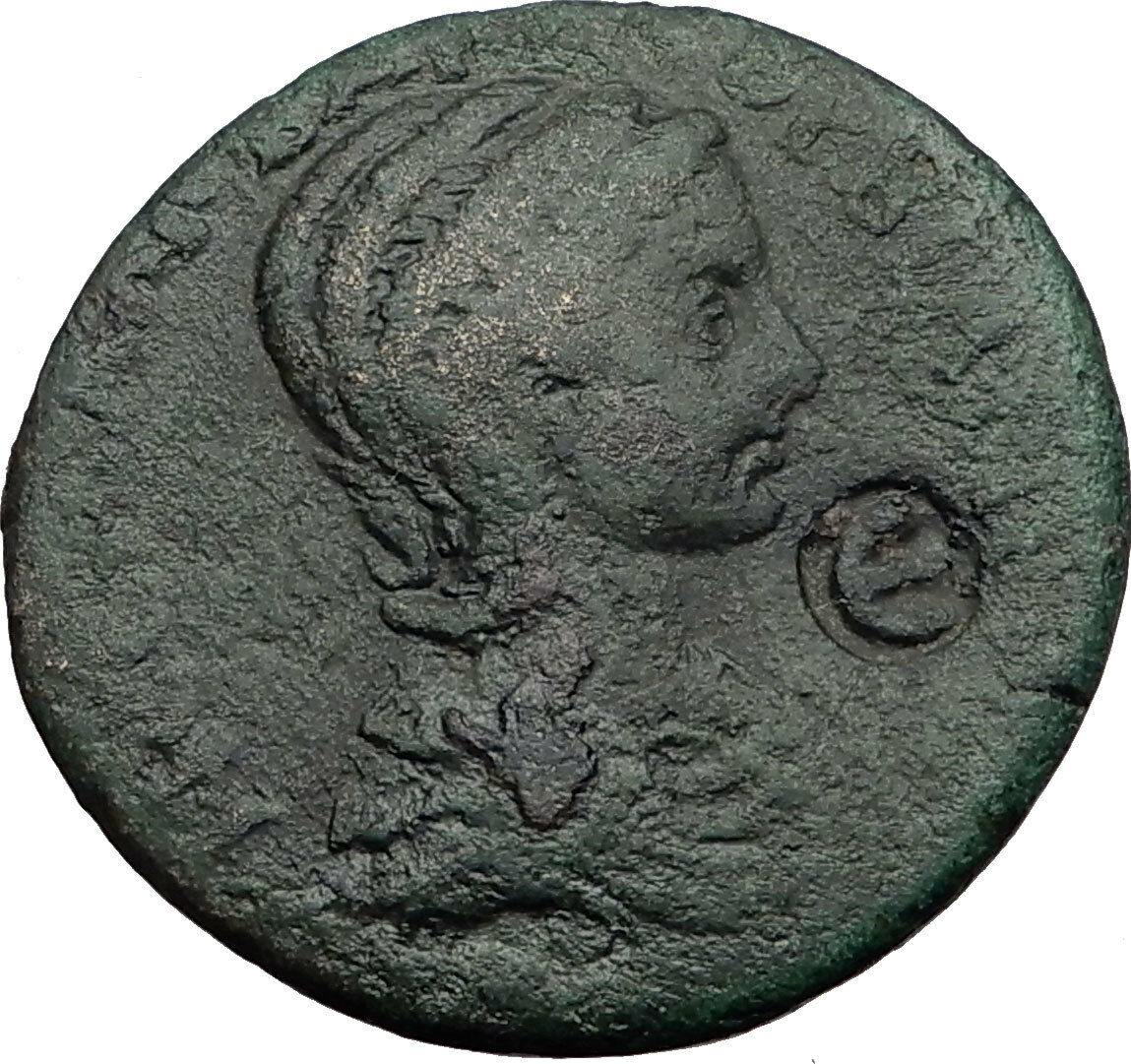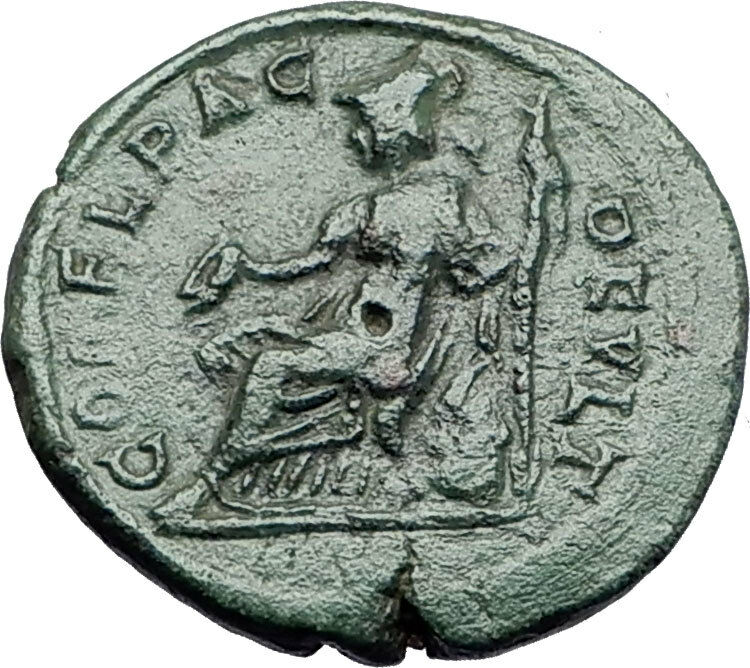|
Hadrian –
Roman Emperor: 117-138 A.D. –
Bronze 12mm (0.95 grams) of
Alexandria in
Egypt
Reference: Dattari 1941
Laureate head right.
Ears of corn, LI A across fields.
You are bidding on the exact item pictured,
provided with a Certificate of Authenticity and Lifetime Guarantee of
Authenticity.
Pietas, translated variously as “duty”, “religiosity” or
“religious behavior”,”loyalty”,”devotion”, or “filial
piety” (English “piety” derives from the Latin), was one of the chief
virtues among the
ancient Romans. It was the distinguishing
virtue of the
founding hero
Aeneas, who is often given the
adjectival epithet pius throughout
Vergil’s epic
Aeneid. The sacred nature of pietas
was embodied by the divine personification Pietas, a goddess often pictured on
Roman coins. The Greek equivalent is
eusebeia.
Cicero defined pietas as the virtue
“which admonishes us to do our duty to our country or our parents or other blood
relations.” The man who possessed pietas “performed all his duties
towards the deity and his fellow human beings fully and in every respect,” as
the 19th-century classical scholar
Georg Wissowa described it.

Livia wife of Augustus as Pietas
As virtue
Pietas erga parentes (“pietas toward one’s parents”) was one of
the most important aspects of demonstrating virtue. Pius as a
cognomen originated as way to mark a person
as especially “pious” in this sense: announcing one’s personal pietas
through official nomenclature seems to have been an innovation of the
late Republic, when
Quintus Caecilius Metellus Pius claimed it for
his efforts to have his father,
Numidicus, recalled from exile.
Pietas extended also toward “parents” in the sense of
“ancestors,” and was one of the basic principles of
Roman tradition, as expressed by the care of
the dead.
Pietas as a virtue resided within a person, in contrast
to a virtue or gift such as
Victoria, which was given by the gods.
Pietas, however, allowed a person to recognize the divine source of benefits
conferred.
The first recorded use of pietas in English occurs in Anselm Bayly’s
The Alliance of Music, Poetry, and Oratory, published in 1789.
Iconography

Denarius of Herennius, depicting Pietas and an act of pietas.
Pietas was represented on coin by cult objects, but also as a woman
conducting a sacrifice by means of fire at an altar. In the imagery of
sacrifice,
libation was the fundamental act that came to
symbolize pietas.
Pietas is first represented on Roman coins on
denarii issued by
Marcus Herennius in 108 or 107 BC. Pietas
appears on the obverse as a divine personification, in
bust form; the quality of pietas is
represented by a son carrying his father on his back.Pietas is among the virtues
that appear frequently on Imperial coins, including those issued under
Hadrian.
One of the symbols of pietas was the stork, described by
Petronius as pietaticultrix, “cultivator
of pietas.” The stork represented filial piety in particular, as the
Romans believed that it demonstrated family loyalty by returning to the same
nest every year, and that it took care of its parents in old age. As such, a
stork appears next to Pietas on
a coin issued by Metellus Pius (on whose
cognomen see
above).
As goddess

Flavia Maximiana Theodora on the
obverse, on the reverse Pietas holding infant to her breast.
Pietas was the divine presence in everyday life that cautioned humans not to
intrude on the realm of the gods. Violations of pietas required a
piaculum, expiatory rites.
A temple to Pietas was vowed (votum)
by
Manius Acilius Glabrio at the
Battle of Thermopylae in 191 BC.
According to a miraculous legend (miraculum),
a poor woman who was starving in prison was saved when her daughter gave her
breast milk (compare
Roman Charity). Caught in the act, the daughter
was not punished, but recognized for her pietasas. Mother and daughter
were set free, and given public support for the rest of their lives. The site
was regarded as sacred to the goddess Pietas (consecratus deae)pietas
erga parentes
Imperial
women portrayed as Pietass
|











